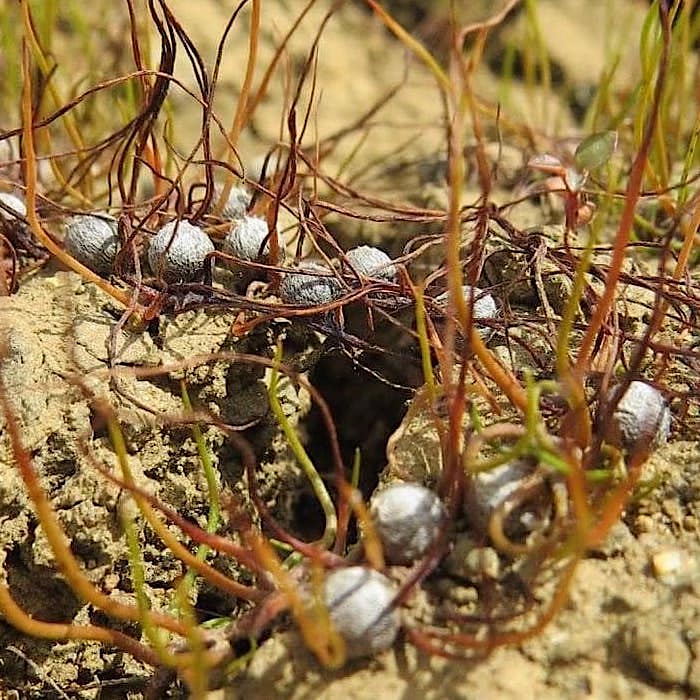
Look out for the rare, small fern Pillwort, which has benefited from conservation work on The Lizard. Ruan Pool on Windmill Farm is a good place to search.
Photo: Steve Townsend
Scientific name: Pilularia globulifera
Other common names: Pepper Grass
Conservation status: UK Biodiversity Action Plan, Priority Species; IUCN Red List, Near Threatened, considered Nationally Scarce in Britain.
What to look for:
- Appearance: The individual green fronds are cylindrical, and can be mistaken for grasses. The fern-like unfurling of the new shoots is a distinguishing feature, as is the presence in summer of the small brown round capsules at the base of the leaves – these are the spore-bearing sporocarps.
- Height: Fronds are between 3 and 10 cm long.
- Where: Neutral to slightly acidic, seasonally dry pools on heathland.
- When: The distinctive sporocarps are best seen between June and September when water levels fall and the spores ripen. The leaves begin to unfurl earlier in the summer.
- Habit: Upright fronds. The plant spreads using creeping rhizomes.
- Similar to: Can be mistaken for the grass or small rushes with which it is often found.
In a good year for Pillwort it is hard to believe that this is a plant that is threatened and which has declined across its range, not just in the UK, but in Europe as well. When conditions are right, this diminutive sub-aquatic fern can carpet whole areas of its favoured muddy heathland habitats. Populations here in the UK are important because they are relatively large but, although found in scattered locations, it is highly localised in its distribution.

Pillwort is one of those Lizard plants that favour the many temporary ponds found on the peninsula – waterbodies that are inundated in the winter but are shallow enough to dry out in the summer. These plants can be found colonising larger ponds, such as Ruan Pool on Windmill Farm, but will also make their home in muddy waterlogged ruts on the old trackways that criss-cross the heaths. One of the main reasons for this preference is a reduction in competition from other more vigorous plant species, which cannot quickly colonise these seasonally changing habitats. Pillwort does well in and at the edges of these muddy pools, forming mats of green and olive-coloured fronds, especially in dry summers when water levels are low.

Individual pillwort plants spread using rhizomes (a creeping stem), each bearing several fronds. Between June and September, as the ponds dry out, sporocarps form at the base of the fronds. These round hairy spheres, up to 3 mm in diameter, are the ‘pills’ that give the plant its name. The sporocarps are probably spread by livestock and waterbirds.
Pillwort faces various threats, including pollution of ponds by herbicides, reduction in grazing and disturbance, and infilling or deepening of ponds. Habitat destruction was the reason for the loss of several sites in the first half of the twentieth century, although new sites have been discovered since 1980, especially in western regions.
Did you know…?
…Pillwort benefits from grazing and trampling by livestock, as this prevents competitor species from taking hold.
…Where there are historic but no current records of Pillwort, there have been some successes in enabling it to return by restoring suitable habitat, such as by redigging or recreating infilled ponds.
More information and references:
Lockton, A.J. (accessed 18/8/2014). Species account: Pilularia globulifera. Botanical Society of the British Isles, www.bsbi.org.uk .
Phillips, R., 1980. Grasses, Ferns, Mosses and Lichens of Great Britain and Ireland. Pan Books, London.
Rose, F., 1989. Colour Identification Guide to the Grasses, Sedges, Rushes and Ferns of the British Isles and North-western Europe. Viking, London.
Published: August 2014
Author: Amanda Scott
Photos: Steve Townsend
